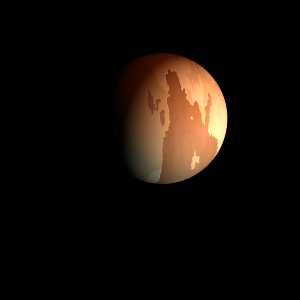|
|
Space Astro
|
Info for exoplanet "Kyahya"
| Scientific (actual) data |
|---|
| Name | Kepler-1091 b |
| Planet status | Confirmed |
| Radius | 0.13 |
| Orbital period | 1.43474 |
| Discovered | 2016 |
| Updated | 2021-02-05 |
| Tconj | 2454970 |
| Publication | Announced on a website |
| Detection type | Primary Transit |
| Alternate names | 2MASS J19590851+4340147 b, K02095.01, KIC 7918992 b, KOI-2095 b, KOI-2095.01, WISE J195908.51+434014.3 b |
| Star name | Kepler-1091 |
| Right ascension | 299.79° |
| Declination | 43.67° |
| Mag j | 13.467 |
| Mag h | 13.09 |
| Mag k | 13.059 |
| Star distance | 915 |
| Star metallicity | 0 |
| Star mass | 1.01 |
| Star radius | 1.03 |
| Star age | 3.47 |
| Star temperature | 5851 |
| Star alternate names | 2MASS J19590851+4340147, KIC 7918992, KOI-2095, WISE J195908.51+434014.3 |
| Wikipedia article | Kepler-1091 b |
Back
| |
| Fictional info (?) |
|---|
| Suggested name | Kyahya |
| Planet type | Cold planet |
| As seen from Kepler-1091, in a frame of reference that rotates with the orbital motion, it appears to rotate only once every two years.
The methane has probably photodissociated, and the free oxygen has been swept into interplanetary space by the solar wind because of the lack of a water layer.
The surface of this unfriendly planet is often dangerous because of the passive minded terraformed herbivores known as "Hyoso Ma". They spend their life hidden in craters by killing anything they find if it is available. Most of them are related to Mannjo Na but with 4 eyes and vary in size from 14 to 30 cm. The Hyoso Ma can thrive at temperatures from 0 to 20°C and to some degree stormy weather which is common on Kyahya. |
| Estimated population | 40000 |
| Atmosphere | Oxygen | 99% |
| Carbon dioxide | 0.45% |
| Methane | 0.18% |
| Water | 0.00011% |
| Atmospheric pressure | 0.2 bar |
 |
| Moon | Mipemo-doji | Huge round oceanic moon |
| Hyomi Futsu-myo | Small round rocky planetoid |
| Borya Chofu Kya | Very small round oceanic asteroid |
| Nyamya-nu | Huge round rocky comet |
| Nyojubyu | Huge almost round rocky asteroid |
| Nunokeja Heragya | Very small round rocky asteroid |
| Pyapyo Paga-gya | Very small irregular rocky moon |
| Segodobyu | Medium-sized round rocky comet |
| Nyusekyu'zuyumu | Medium-sized potato shaped crater-filled comet |
| Ryabyano'zo | Small round oceanic asteroid |
| Dagyo Mehya'ryu | Medium-sized slightly egg-shaped gaseous moon |
| Kiajuri-mato | Medium-sized potato shaped rocky asteroid |
| Yokyorya-nyujosho | Large irregular ice asteroid |
| Shoku Kyu | Small slightly egg-shaped oceanic moon |
| Nyoga Yomiyo | Huge round gaseous planetoid |
| Hosho Moga | Huge round oceanic planetoid |
| Fushi Namopu Sha | Very small irregular rocky comet |
| Hafu-pa | Large almost round rocky asteroid |
| Mihechu Myoshu | Small irregular crater-filled moon |
| Gekuna-pyu | Huge irregular ice moon |
| Google search for Kyahya |
|
Website by Joachim Michaelis
|
|
|
|